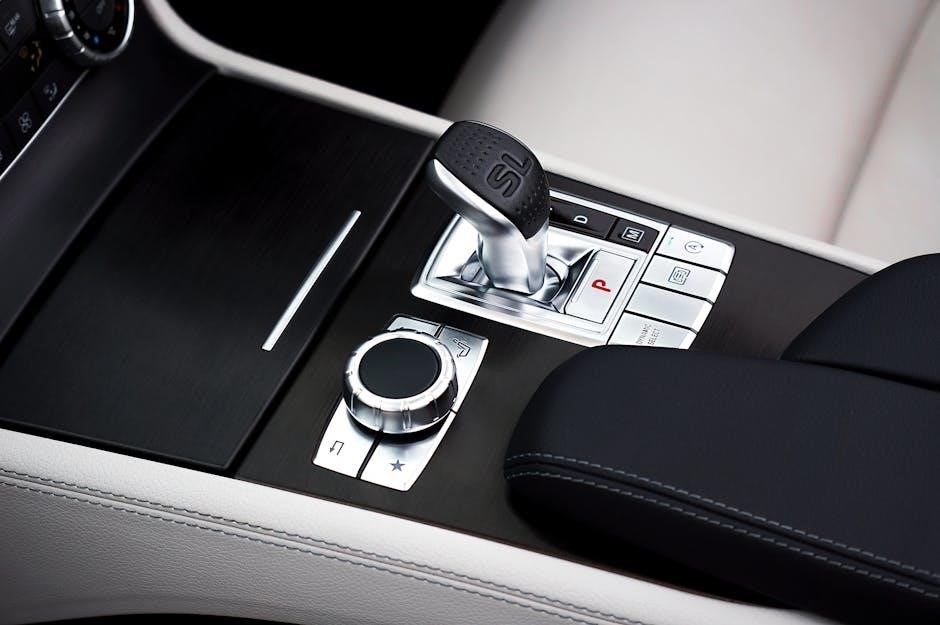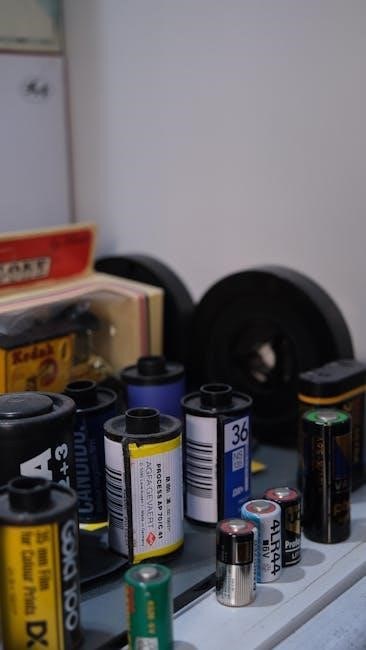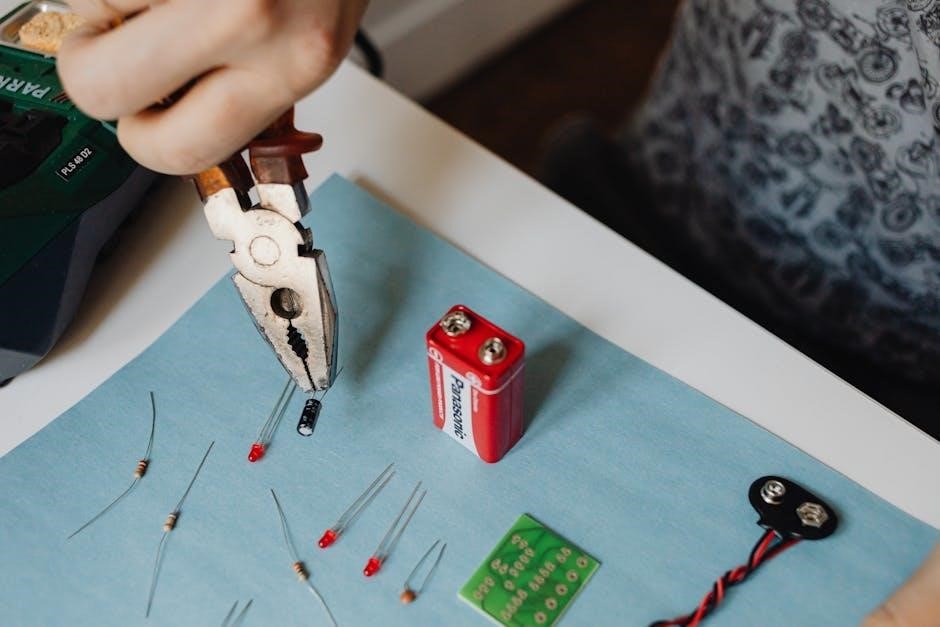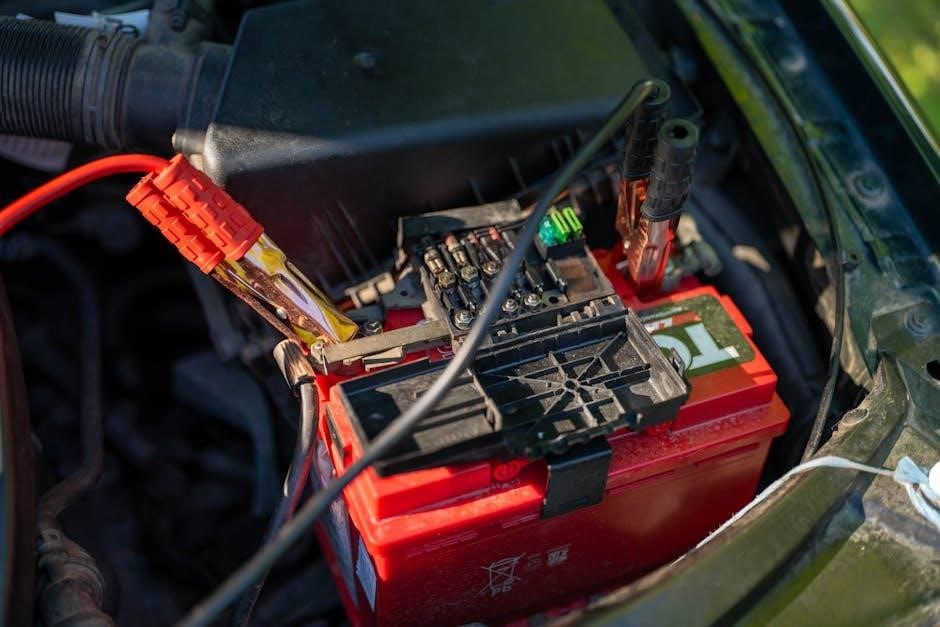Understanding the “12V Battery: See Owner’s Manual” Warning
The “12V Battery: See Owner’s Manual” warning indicates a potential issue with the vehicle’s 12V battery system. It suggests checking the owner’s manual for guidance on diagnosing and addressing the problem, which may relate to low voltage, faulty charging, or cold weather impact on battery performance.
1.1 What the Warning Means
The “12V Battery: See Owner’s Manual” warning signals a potential issue with the vehicle’s 12V battery system. It may indicate low voltage, a faulty battery, or charging system problems. Cold weather can also trigger this warning, as it affects battery performance. The message prompts the driver to consult the owner’s manual for guidance on diagnosing and resolving the issue to prevent further complications.

1.2 Common Scenarios When the Warning Appears
The “12V Battery: See Owner’s Manual” warning often appears in cold weather, as low temperatures reduce battery performance. It may also show after short drives, insufficient charging, or when high-drain features are used heavily. In some cases, the warning can indicate a faulty battery or charging system, prompting immediate consultation of the owner’s manual for troubleshooting guidance.
How to Check the 12V Battery Voltage
To check the 12V battery voltage, locate the battery, typically under the hood or trunk. Use a multimeter set to 20V DC. Connect the red probe to the positive terminal and black to negative. Measure voltage with the engine off. A fully charged battery reads ~12.6V. Lower readings may indicate issues. Ensure safety and accuracy throughout the process.
2.1 Steps to Measure Battery Voltage
Gather a multimeter and ensure it’s set to 20V DC. Locate the 12V battery, often found under the hood or in the trunk. Wear gloves for safety. Connect the multimeter’s red probe to the positive terminal and the black probe to the negative terminal. Avoid short circuits. Measure voltage with the engine off. Record the reading to assess battery health. Ensure accuracy and safety throughout the process.
2.2 Interpreting Voltage Readings
A healthy 12V battery typically reads 12.6V when fully charged. A reading below 12.4V indicates partial discharge, while below 12V signals a deeply discharged battery. If voltage drops below 10V, damage may occur. With the engine running, voltage should rise to 13.5-14.5V, indicating the alternator is charging. Low or inconsistent readings suggest issues like a faulty alternator or bad battery cells. Always refer to the owner’s manual for specific guidelines.

Causes of the 12V Battery Warning
The warning may appear due to low battery voltage, a faulty charging system, or cold weather impacting battery performance. These issues can trigger the alert, prompting manual guidance.
3.1 Low Battery Voltage
Low battery voltage is a common trigger for the warning. If the voltage drops below 12.4 volts, the system detects an issue. Prolonged discharge from accessories like headlights or cold weather can cause this. Always check the voltage and ensure it meets the specified range to prevent false warnings and potential battery damage.
3.2 Faulty Battery or Charging System
A faulty battery or charging system can trigger the warning. Issues like a failing alternator or bad battery cells may cause inconsistent power supply. Mercedes recommends diagnosing and replacing such components at an authorized service center to ensure compatibility and proper system reset, avoiding further electrical issues.
3.3 Cold Weather Impact
Cold weather can significantly affect the 12V battery’s performance, triggering the warning. Low temperatures slow chemical reactions, reducing battery capacity. Symptoms may include the “12V Battery: See Owner’s Manual” message and loss of features like the backup camera. Mercedes recommends winter care, such as using approved chargers and ensuring the battery is fully charged before extreme cold to maintain reliability and prevent system shutdowns.
Troubleshooting the 12V Battery Issue
Troubleshooting involves using a multimeter to measure voltage and inspecting terminals for corrosion or looseness; Consult the owner’s manual for specific guidance on diagnosing issues accurately.
4.1 Using a Multimeter for Diagnosis
Using a multimeter, measure the battery voltage by connecting the positive probe to the positive terminal and the negative probe to the negative terminal. A healthy battery should read around 12.4-12.7 volts. If the voltage is significantly lower, it indicates a potential issue. Ensure proper connections and avoid reverse polarity to prevent damage. Refer to the owner’s manual for specific guidelines on interpreting readings and safety precautions.
4.2 Checking Battery Terminals and Connections
Inspect the battery terminals for corrosion, dirt, or loose connections, which can disrupt power supply. Clean the terminals with a wire brush if necessary and ensure they are tightly secured. Verify that the battery cables are in good condition and properly connected to the vehicle’s electrical system. Secure connections are essential for maintaining proper battery function and preventing system malfunctions.
Replacing the 12V Battery
Replacing the 12V battery involves removing the faulty unit and installing a new one that meets Mercedes-Benz specifications. Ensure the replacement battery is compatible with your vehicle’s electrical system. The process is straightforward but requires care to avoid damaging other components. Costs typically range between $250-$300, including labor and system reset fees.
5.1 Steps to Replace the Battery
To replace the 12V battery, start by disconnecting the negative terminal to prevent electrical surges. Remove the old battery and install the new one, ensuring it meets Mercedes-Benz specifications. Reconnect the terminals securely, starting with the positive terminal. Finally, reset the vehicle’s electrical system, which may require specialized tools or a visit to a Mercedes-Benz Service Centre for proper calibration.
5.2 Resetting the Vehicle’s Electrical System
After replacing the battery, reset the vehicle’s electrical system to ensure proper functionality. This process may vary by model and typically requires a scan tool or a series of ignition cycles. Consult the owner’s manual for specific instructions. Some systems automatically reset after a short drive, while others need manual recalibration. Proper reset is crucial to avoid issues with electrical components and systems.
Cost of Replacing the 12V Battery
Replacing the 12V battery typically costs between $250-300, including labor and system reset fees, depending on the service center or dealership performing the replacement.
6.1 Battery Replacement Cost
The cost to replace a Mercedes 12V battery typically ranges from $250 to $300. This includes the price of a genuine Mercedes-approved battery and labor fees. Costs may vary depending on the service center or dealership performing the replacement. Ensure the battery meets specific vehicle requirements for optimal performance and reliability.
6.2 Additional Costs for Labor and System Reset
Replacing the 12V battery may incur additional costs for labor and system reset. Labor fees can range from $50 to $150, depending on the service center. Resetting the vehicle’s electrical system, required after battery replacement, may add extra charges. These costs ensure proper reinitialization of vehicle systems, such as electrical and infotainment functions, for optimal performance and functionality.
Preventive Maintenance for the 12V Battery
Regularly check battery terminals for cleanliness and tight connections. Avoid deep discharge by limiting unnecessary electrical load. Use approved chargers and follow manual guidelines for optimal battery health.
7.1 Best Practices for Battery Care
Regularly inspect battery terminals for corrosion and ensure they are tightly connected. Avoid deep discharging by limiting unnecessary electrical load when the engine is off. Use only approved chargers and follow the owner’s manual guidelines for charging procedures. Keep the battery clean and dry, and monitor voltage levels during extreme weather conditions to maintain optimal performance and longevity.
7.2 Avoiding Deep Discharge
Avoiding deep discharge is crucial for extending battery life. Ensure the battery voltage does not drop below 12.4V, as prolonged low voltage can damage the battery. Limit unnecessary electrical load when the engine is off and avoid frequent short drives that prevent the alternator from fully recharging the battery. Monitor voltage levels and recharge promptly if they fall too low.

Approved Chargers for Mercedes-Benz 12V Battery
Only use chargers tested and approved for Mercedes-Benz. Refer to the owner’s manual for recommendations. Ensure safety guidelines are followed to maintain battery health and vehicle functionality.
8.1 Recommended Chargers
Mercedes-Benz recommends using chargers specifically tested and approved for their 12V batteries. These chargers ensure compatibility and safety, meeting the vehicle’s electrical system requirements. Always refer to the owner’s manual for a list of approved chargers and follow the manufacturer’s instructions for proper charging procedures to maintain battery health and prevent potential damage to the vehicle’s electrical components.
8.2 Safety Guidelines for Charging
When charging the 12V battery, always use approved chargers and follow the manufacturer’s instructions. Ensure the vehicle is in a well-ventilated area, away from open flames or sparks. Avoid incorrect cable connections to prevent short circuits. Never charge a damaged or frozen battery. Always disconnect the negative terminal first and reconnect it last to avoid electrical surges. Keep children away from the charging process.

Jump-Starting the Vehicle
Jump-starting the vehicle requires a donor car with a similar 12V battery. Connect positive terminals first, then negative to prevent electrical surges. Avoid overcharging and ensure proper connections for safe starting. Always refer to the owner’s manual for specific instructions.

9.1 Safe Jump-Starting Procedures
Always connect the positive clamp to the donor battery’s positive terminal and the negative clamp to a grounded metal part on the vehicle. Use a compatible booster battery or another vehicle with a similar 12V system. Avoid overcharging and ensure all electrical systems are off. Connect positive first, then negative to prevent sparks. Follow the owner’s manual for specific instructions and safety guidelines.
9.2 Connecting the Donor Battery
Connect the positive jumper cable to the donor battery’s positive terminal and the other end to your vehicle’s positive terminal. Next, attach the negative cable to the donor battery’s negative terminal and the other end to a grounded metal part on your vehicle. Ensure both vehicles are in neutral or park gear with engines off. Avoid cross-connecting cables improperly to prevent damage or sparks. Always use a compatible donor battery and follow the owner’s manual for specific instructions.

Impact of Cold Weather on the 12V Battery
Cold weather reduces 12V battery performance by slowing chemical reactions, reducing capacity, and lowering voltage. Prolonged exposure can trigger the “See Owner’s Manual” warning due to voltage drop.

10.1 How Cold Affects Battery Performance
Cold weather significantly impacts 12V battery performance by slowing internal chemical reactions, reducing capacity, and lowering voltage levels. This can lead to the “See Owner’s Manual” warning in Mercedes vehicles due to decreased battery efficiency. Prolonged exposure to freezing temperatures accelerates degradation, making it crucial to follow winter maintenance guidelines outlined in the owner’s manual to ensure reliable operation.
10.2 Winter Care Tips
To maintain your Mercedes 12V battery in cold weather, ensure it is fully charged before winter. Avoid deep discharge by limiting short drives and keeping the vehicle in a garage. Clean terminals and secure connections to prevent issues. Consider using a battery blanket or trickle charger to maintain temperature. Check battery health before winter and avoid excessive accessory use while parked.

Notes on High-Voltage Battery Charging
Differences exist between 12V and high-voltage batteries. High-voltage charging follows specific guidelines, ensuring safety and efficiency. Always refer to the owner’s manual for detailed instructions and precautions.
11.1 Differences Between 12V and High-Voltage Batteries
The 12V battery powers standard vehicle systems, while high-voltage batteries are used in electric or hybrid vehicles for propulsion. High-voltage systems operate at significantly higher voltages, typically between 300-400V, and are designed for energy storage and electric motor operation. They require specialized charging units and safety protocols due to their complex technology and higher energy capacity.
11.2 Charging Guidelines
Charging the high-voltage battery requires using approved chargers and following safety guidelines to avoid damage or risk. Always refer to the owner’s manual for specific instructions, as high-voltage systems demand specialized care. Ensure the charger is compatible with your Mercedes-Benz model to maintain optimal performance and safety standards. Proper charging helps preserve battery health and ensures reliable vehicle operation.

The “12V Battery: See Owner’s Manual” warning highlights the importance of addressing battery issues promptly. Regular checks, proper charging, and following manual guidelines ensure optimal performance and longevity of your Mercedes-Benz vehicle.
12.1 Summary of Key Points
The “12V Battery: See Owner’s Manual” warning signals potential issues with the battery system, such as low voltage, faulty charging, or cold weather impact. Regular monitoring, proper charging, and adhering to manual guidelines are essential for maintaining optimal performance. Addressing these issues promptly ensures reliability and prevents unexpected breakdowns, emphasizing the importance of proactive care for your Mercedes-Benz vehicle.
12.2 Importance of Following Owner’s Manual Instructions
Adhering to the owner’s manual is crucial for diagnosing and resolving the “12V Battery” warning. It provides specific guidance tailored to your Mercedes-Benz model, ensuring safe and effective troubleshooting. Ignoring manual instructions can lead to improper handling, potential damage, or system malfunctions. Following recommended procedures guarantees optimal performance, safety, and compliance with manufacturer standards, preserving your vehicle’s reliability and longevity.